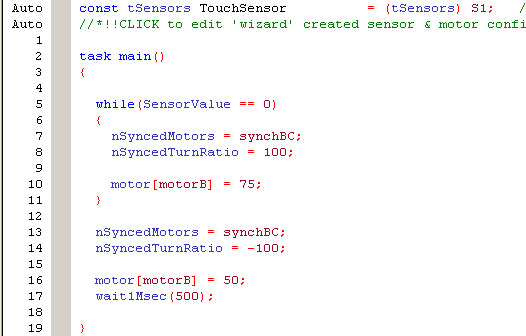

Line Following with a P Controllerĭo you like Maths? I don't. So why not make the turn proportional to the error, the difference between the midpoint and the value read. so if we want to improve it even more we could add even more states, far left, left, a bit left, straight, a bit right, right, far right, and so on. add an extra state to make it go straight. Why? Because we have only two states, so the robot is either turning left or turning right. If the corner is step enough the robot will miss it and as you can see it is missing the straight line and it starts oscillating around it.
#ROBOTC PID CONTROL DOWNLOAD#
( You can download all the source codes on the bottom of the page )ĭoes it works? Well. The idea is pretty simple just make one wheel turns faster than the other. We place the robot on the line, we get a reading if it below the middle ( black-white ) we move to one side and if it is above we move to the other side. Let’s start with the simplest possible way ( and perhaps the worse ) of doing line following. Let’s think first what we are going to do. Ok, we have the robot, we have the calibration data… let’s go code. I do it each time I start the robot but you can safely ignore it while light conditions keep stable. So the idea is that you place it on the white surface, press the touch sensor, place it now on the black surface and press the touch sensor again, now we have the white and black readings and can start working. The reflected light value is just a number between 0 and 100 with the amount of light the sensor is getting back.ĭo you get the idea? We add a Touch sensor to our Robot to record the light value, you can also do it using Brick buttons, as you prefer. Ok, as you know Color sensor can also work as a Light sensor, so we choose the Measure reflected light mode and we are going to store in two variables the white and black colors. So the best thing you can do, before starting anything else is calibrate the robot. I hope you have a clear idea of what these two colors are, but unfortunatelly your robot don’t. So, next step is defining what it is black and what it is white.

We want to follow the line where there is a 50% of white and a 50% of black. No, serious, we don’t follow the line but its border in what it is called left-hand approach. Right? Well, first thing that we need to understand is that we don’t want to follow the line ( wtf?! )… We have a thick black line on a white surface and we want our robot to move along the line following it in the fastest possible way. It is quite important to understand the line following problem first. So it may work too on yours unless it has even less contrast than mine. My floor is done of marble that it is white and brown at times and even with that it works. You don’t need a closed loop ( although it is a good idea to do it in that way ). I have used a black tape and with the finger I have sticked it to the floor creating a continuous path that the robot will follow. If you happen to have the Mindstorms NXT 2.0 it has a mat with a big elipse-like line that works great for this tasks.īut if you don’t just do like me. But before start coding, we need the line that the robot will follow. Building your playground for line following Let me explain how we get to the “best” solution with a serie of intermediate steps that will help you understand it better. Whatever you build, just try to keep the distance between wheels to a minimum… because the bigger the distance, the harder for the robot to follow the turns on the line. Or base it on one of the LEGO Education models… You can download the instructions provided by LEGO.

So first thing is build yourself a little robot much like Track3r, either with wheels or with tracks. The more sensors you have the better and faster the robot will be able to follow it.
#ROBOTC PID CONTROL HOW TO#
On this tutorial I will explain how to do line following with just one sensor. As you know, both Mindstorms and EV3 sets come with a little light sensor that it is able to get a reading of reflected light, apart of seeing colors. There are several ways of making a Line Follower, the one that I am going to explain you about is using the Light sensor. Line following is one of the most common problems on industrial robots, and it is one of the most useful applications because it allows the robot to move from one point to another to do tasks. The first thing you have thought about after unboxing your LEGO Mindstorms was building the first robot, and just after that you would love to make it follow lines, isn’t it? The easy way of learning how to built your own Line follower Robot using a PID Controller without any of the mathematical expressions that you will find on most tutorials.


 0 kommentar(er)
0 kommentar(er)
